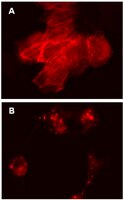17-10203 Sigma-AldrichLentiBrite™ RFP-β-actin Lentiviral Biosensor
Recommended Products
Overview
| Replacement Information |
|---|
Key Specifications Table
| Key Applications | Detection Methods |
|---|---|
| TFX, IF, ICC, Track single cell and cell population migration (migration assay, cell culture) | Fluorescent |
| Description | |
|---|---|
| Catalogue Number | 17-10203 |
| Trade Name |
|
| Description | LentiBrite™ RFP-β-actin Lentiviral Biosensor |
| Overview | Read our application note in Nature Methods! http://www.nature.com/app_notes/nmeth/2012/121007/pdf/an8620.pdf (Click Here!) Learn more about the advantages of our LentiBrite Lentiviral Biosensors! Click Here Biosensors can be used to detect the presence/absence of a particular protein as well as the subcellular location of that protein within the live state of a cell. Fluorescent tags are often desired as a means to visualize the protein of interest within a cell by either fluorescent microscopy or time-lapse video capture. Visualizing live cells without disruption allows researchers to observe cellular conditions in real time. Lentiviral vector systems are a popular research tool used to introduce gene products into cells. Lentiviral transfection has advantages over non-viral methods such as chemical-based transfection including higher-efficiency transfection of dividing and non-dividing cells, long-term stable expression of the transgene, and low immunogenicity. EMD Millipore is introducing LentiBrite™ Lentiviral Biosensors, a new suite of pre-packaged lentiviral particles encoding important and foundational proteins of autophagy, apoptosis, and cell structure for visualization under different cell/disease states in live cell and in vitro analysis.
EMD Millipore’s LentiBrite™ RFP-β-actin lentiviral particles provide bright fluorescence and precise localization to enable live cell analysis of actin microfilament dynamics in difficult-to-transfect cell types. |
| Background Information | Actin is a highly abundant globular protein found in the cytosol of all eukaryotic cells that assembles in a head-to-tail arrangement to form double helical, polarized microfilaments. Actin microfilaments constitute one of the 3 major cytoskeletal structures, and they participate in many important cellular processes including muscle contraction, cell motility, cytokinesis, vesicle and organelle movement, cell signaling, the establishment and maintenance of cell junctions and cell shape. In vertebrates, three main groups of actin isoforms, alpha, beta, and gamma, have been identified; in most cell types, β–actin is the primary component of the cytoskeleton. Fusions of fluorescent proteins to β-actin have proven very useful tools in elucidating the dynamics of actin microfilaments in many cellular processes. EMD Millipore’s LentiBrite™ RFP-β-actin lentiviral particles provide bright fluorescence and precise localization to enable live cell analysis of actin microfilament dynamics in difficult-to-transfect cell types. |
| References |
|---|
| Product Information | |
|---|---|
| Components |
|
| Detection method | Fluorescent |
| Quality Level | MQ100 |
| Biological Information | |
|---|---|
| Gene Symbol |
|
| Purification Method | PEG precipitation |
| UniProt Number | |
| Physicochemical Information |
|---|
| Dimensions |
|---|
| Materials Information |
|---|
| Toxicological Information |
|---|
| Safety Information according to GHS |
|---|
| Safety Information |
|---|
| Product Usage Statements | |
|---|---|
| Quality Assurance | Evaluated by transduction of HT-1080 cells and fluorescent imaging performed for assessment of transduction efficiency. |
| Usage Statement |
|
| Packaging Information | |
|---|---|
| Material Size | 1 vial (minimum of 3 x 10E8 IFU/mL) |
| Transport Information |
|---|
| Supplemental Information |
|---|
| Specifications |
|---|
| Global Trade Item Number | |
|---|---|
| Catalog Number | GTIN |
| 17-10203 | 04053252633744 |
Documentation
LentiBrite™ RFP-β-actin Lentiviral Biosensor SDS
| Title |
|---|












